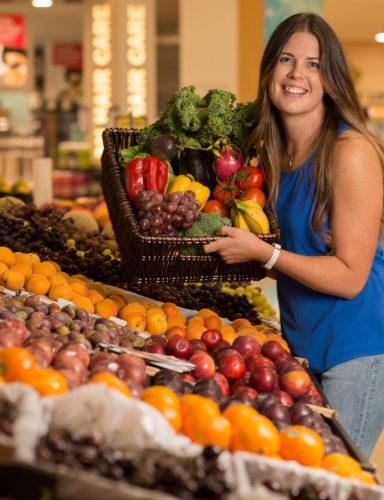SUPER foods don’t have an agreed upon definition but there’s a general consensus they contain superior amounts of nutrition (vitamins, minerals, antioxidants, essential fats, etc) compared to other foods in their class, says Canberra-based nutritionist Kate Freeman.
“For example, broccoli is superior to zucchini and green beans when it comes to vitamins and other phytochemicals [plant chemicals with health promoting properties] – which in turn makes it ‘super’,” says Kate, who has more than 10 years’ experience in the health and nutrition industry.
Super foods are also typically high in vitamins, minerals and/or essential fats, don’t have excessive energy density and are high in antioxidants, polyphenols and other health-promoting components, she says.
“In a culture where over-consumption of energy and poor nutrition is highly prevalent, choosing Super Foods is really about getting the maximum nutritional ‘bang’ for the lowest amount of energy,” she says.
We’ve picked some of the most popular Super Foods and asked Kate to reveal whether they truly have benefits – or whether they’re best left on the shelf.

Nutritionist Kate Freeman… “Choosing Super Foods is really about getting the maximum nutritional ‘bang’ for the lowest amount of energy.”
Photo by Gary Schafer, taken at Majestic Fresh, Canberra Centre
1. Blueberries, Acai, Goji berries
The whole berry family contains lots of antioxidant and vitamin rich fruits such as blueberries, raspberries, strawberries, cranberries, inca berries, acai berries and goji berries. The great thing about berries in particular is their high antioxidant content and very low sugar content. This makes them great low-kilojoule snacks that offer maximum amounts of nutrition. Antioxidants protect the body from damage against free radicals, which cause some cancers.
Although acai and goji berries are included in this group, their use has become somewhat of a fad, with their exuberant health claims and excessive prices. Most of the time the promoted products are powders, extracts or dried versions of the original berries that are often highly processed. In my opinion, fresh food is always better. Dried fruit often has added sugar, so check ingredients lists and labels.
2. Chia seeds
Chia seeds are a great source of omega 3s and are a fantastic way to ensure intake of these essential fats for people who don’t like seafood. They can be easily added to salads, breakfast cereals and smoothies.
3. Broccoli
All green leafy vegetables could be regarded as super foods. Specifically broccoli and kale get the most attention in this group, but other green leafy vegetables such as Brussels sprouts and spinach are also worth a mention. Broccoli contains a significant amount of vitamin C, vitamin K, folate and beta carotene (converted to vitamin A by the body).
All of these vitamins are essential for good health. Broccoli also contains fibre and a substance called sulforaphane which has anti-cancer properties. Vitamin C helps keep immune systems functioning well, is vital for good collagen formation in the skin and also helps the body absorb iron from food. 100g of broccoli meets the recommended daily intake for vitamin C.
4. Lentils
Lentils are rich in carbohydrate and fibre, offering a great source of sustainable energy throughout the day. Half a cup of boiled lentils is only 100 calories yet it contains 6g of dietary fibre. They are also a good source of protein as well as offering potassium, vitamin B12, iron and magnesium.
5. Cacao beans
Cacao and cocoa beans are one and the same. The use of the word cacao has become somewhat of a fad as the average consumer thinks they’re eating a better type of chocolate.
Whether cacao or cocoa, researchers will tell you that these beans are very rich in antioxidants known as procyanidins, shown to be very good at improving cardiovascular health in particular. The problem lies in the confusion that consumers face with different products. Obviously, the more of the bean that’s used in the product the more antioxidants that will be present.
In most cases, specifically chocolate, the amount of antioxidant that you gain in relation to the amount of added fat, sugar and overall energy wouldn’t class it as a super food. Chocolate is extremely energy dense and easy to overeat. In my opinion there are better ways to get your antioxidants.
6. Salmon
Salmon, in particular atlantic salmon, is a very rich source of the essential omega 3 fatty acids. The role and health benefits of omega 3 are extremely diverse within the body. For young children especially, omega 3 is essential for healthy brain development and growth of the central nervous system.
Not only does salmon contain high amounts of healthy fats, it’s also a great source of many vitamins and minerals including most of the B vitamins, vitamin A, vitamin C, selenium, iron, zinc, magnesium and phosphorous.
Aim for children to have about two serves of salmon or other fatty fish (tuna, sardines, mackerel) a week.
7. Natural yoghurt
Yoghurt offers lots of essential nutrients; calcium, potassium, magnesium, phosphorous and vitamin B12.
An adequate calcium intake is essential maintenance of strong bones and teeth, particularly in childhood. Good bone acquisition during childhood and adolescence decreases your risk of osteoporosis in late adulthood. Children and teenagers need up to 1300mg of calcium per day. Yoghurt is a fantastic source of calcium with 150g offering up to 50 per cent of a child’s daily calcium needs.
The other way natural yoghurt reaches super food status is due to the presence of friendly bacteria. These bacteria populate the gastrointestinal tract and help keep the balance of good and bad bacteria in check making you less prone to illness and infection.
When purchasing yoghurt, check the ingredients list for the addition of friendly cultures such as lactobacillus acidophilus. The less ingredients in the list the better. Avoid yoghurts which have excessive amounts of added sugar, artificial sweeteners, thickeners and other additives.
Photo by Gary Schafer, taken at Majestic Fresh, Canberra Centre
The post The secrets to selecting ‘super foods’ appeared first on Canberra CityNews.